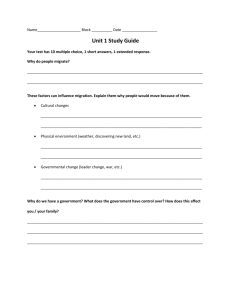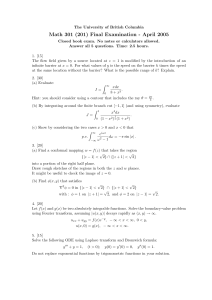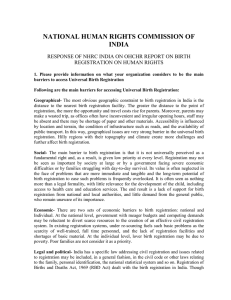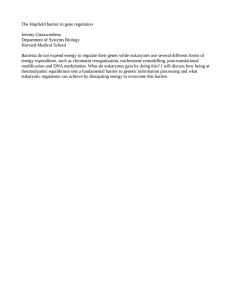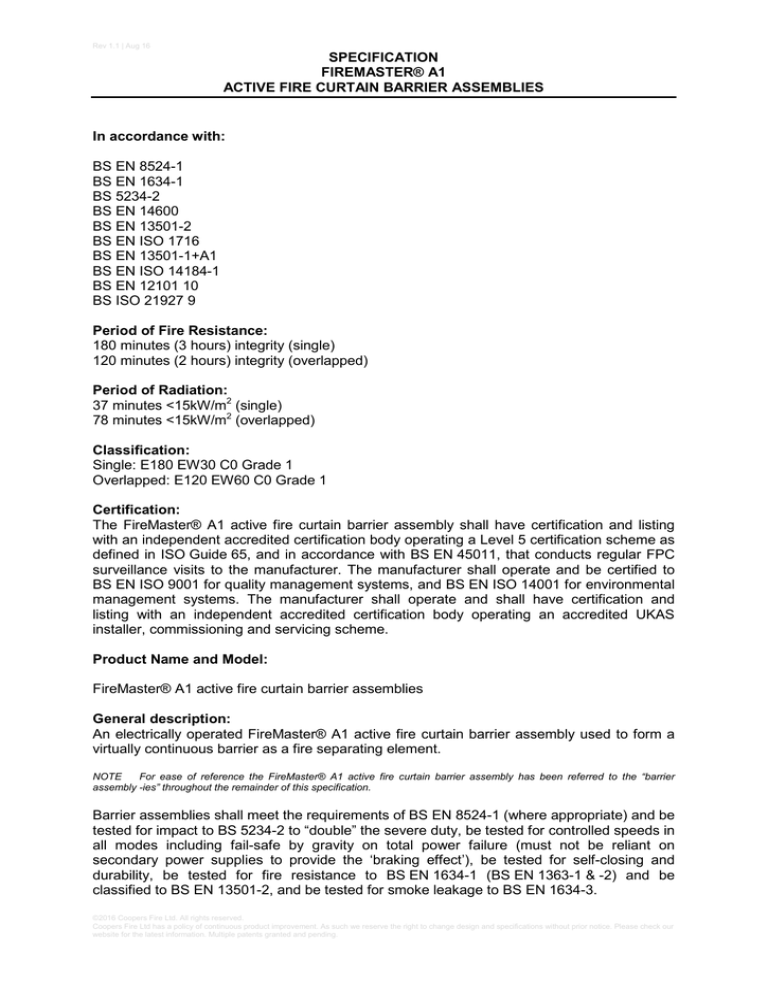
Rev 1.1 | Aug 16
SPECIFICATION
FIREMASTER® A1
ACTIVE FIRE CURTAIN BARRIER ASSEMBLIES
In accordance with:
BS EN 8524-1
BS EN 1634-1
BS 5234-2
BS EN 14600
BS EN 13501-2
BS EN ISO 1716
BS EN 13501-1+A1
BS EN ISO 14184-1
BS EN 12101 10
BS ISO 21927 9
Period of Fire Resistance:
180 minutes (3 hours) integrity (single)
120 minutes (2 hours) integrity (overlapped)
Period of Radiation:
37 minutes <15kW/m2 (single)
78 minutes <15kW/m2 (overlapped)
Classification:
Single: E180 EW30 C0 Grade 1
Overlapped: E120 EW60 C0 Grade 1
Certification:
The FireMaster® A1 active fire curtain barrier assembly shall have certification and listing
with an independent accredited certification body operating a Level 5 certification scheme as
defined in ISO Guide 65, and in accordance with BS EN 45011, that conducts regular FPC
surveillance visits to the manufacturer. The manufacturer shall operate and be certified to
BS EN ISO 9001 for quality management systems, and BS EN ISO 14001 for environmental
management systems. The manufacturer shall operate and shall have certification and
listing with an independent accredited certification body operating an accredited UKAS
installer, commissioning and servicing scheme.
Product Name and Model:
FireMaster® A1 active fire curtain barrier assemblies
General description:
An electrically operated FireMaster® A1 active fire curtain barrier assembly used to form a
virtually continuous barrier as a fire separating element.
NOTE
For ease of reference the FireMaster® A1 active fire curtain barrier assembly has been referred to the “barrier
assembly -ies” throughout the remainder of this specification.
Barrier assemblies shall meet the requirements of BS EN 8524-1 (where appropriate) and be
tested for impact to BS 5234-2 to “double” the severe duty, be tested for controlled speeds in
all modes including fail-safe by gravity on total power failure (must not be reliant on
secondary power supplies to provide the ‘braking effect’), be tested for self-closing and
durability, be tested for fire resistance to BS EN 1634-1 (BS EN 1363-1 & -2) and be
classified to BS EN 13501-2, and be tested for smoke leakage to BS EN 1634-3.
©2016 Coopers Fire Ltd. All rights reserved.
Coopers Fire Ltd has a policy of continuous product improvement. As such we reserve the right to change design and specifications without prior notice. Please check our
website for the latest information. Multiple patents granted and pending.
Rev 1.1 | Aug 16
SPECIFICATION
FIREMASTER® A1
ACTIVE FIRE CURTAIN BARRIER ASSEMBLIES
Description:
Active fire curtain barrier assemblies shall comprise of a fire resistant fabric which is wound
on to a steel roller, with 1:600 deflection performance to BS 6323-5, which is powered by an
internal 24Vdc electric motor. They are enclosed within a 1.2 mm (0.047 in) galvanized mild
steel box. A bottom bar to suit the deflection performance requirements of the project and
the desired ceiling configuration in fitted to the bottom edge of the fabric curtain.
Motors shall meet all applicable safety standards. Motors shall contain the necessary drive
mechanisms, a mechanical epicyclic gearbox retarder, automatic overload protection and
both automatic and manual distance travel positioning, linked to an internal 24Vdc
electromagnetic brake with regenerative braking system. When motors are retracted their
internal drive motor shall be isolated from all power and the barrier shall be held in position
by an internal electromagnetic brake. This ensures the barriers not drift upward or
downward.
Additionally, motors shall be tested for reliability, durability and self-closing to BS EN 8524-1
Annex E and shall be tested for operation at temperatures of 400 °C (752 °F) as required by
BS EN 8524-1 Annex G.
The barrier assemblies shall operate with fail-safe by gravity, using patented true TOTAL
(TGFS), in accordance with BS EN 8524-1 Annex D, and be able to move to their fire
operational position even in the event of open or closed circuit wiring, or total system
corruption, with controlled braking system and drive mechanisms. All working parts shall be
totally enclosed and protected within the steel roller and shall be tested as part of the
complete assembly for fire resistance.
The barrier assemblies must show the tested ability to use a range of heavy bottom bar
weights to ensure positive operation when subjected to pressure. The Engineer shall declare
to the manufacturer such pressures, or wind loads in advance to ensure operational
conformity.
The barrier assemblies must show the ability to operate with the barrier retained in side
channels to resist pressure (as standard 20Pa) and impact (Double Severe Duty) and
remove edge gaps in accordance with BS EN 8524-1 Annex D.
Primary, secondary and auxiliary power supplies shall be CE Marked in accordance with the
Construction Products Regulations (305/2011) when tested to BS EN 12101-10. Control
panels shall be tested to BS ISO 21927-9.
All power supplies and control panels shall be tested in accordance with the Low Voltage
Directive (2006/95/EC) BS EN 61010-1, EMC Directive (2004/108/EC) BS EN 12101-10,
BS EN 61000-6-3 and BS EN 50130-4, Machinery Directive (2006/42/EC) and ROHs
Directive (2011/65/EU).
Any optional ancillary devices shall be tested as part of a complete specimen to
BS EN 8524-1 Annex H.
©2016 Coopers Fire Ltd. All rights reserved.
Coopers Fire Ltd has a policy of continuous product improvement. As such we reserve the right to change design and specifications without prior notice. Please check our
website for the latest information. Multiple patents granted and pending.
Rev 1.1 | Aug 16
SPECIFICATION
FIREMASTER® A1
ACTIVE FIRE CURTAIN BARRIER ASSEMBLIES
Operation:
The barrier assemblies shall move to their fire operational position in a controlled manner
when all consumable primary and auxiliary power sources are removed, in the event the
wiring, open or short circuit, or system corruption, or any combination thereof.
The barrier assemblies shall fail-safe by gravity, using patented true TOTAL (TGFS), and
‘drive up’ with mains power available. In the event of mains power failure, they shall remain
retracted using their own dedicated battery back-up power supply for a pre-determined
period (nominally 30 minutes). If signalled to descend during this period they shall fail-safe
by gravity in a controlled manner to their fire operational position. At the end of the predetermined time delay they shall fail-safe by gravity in a controlled manner. This safety
feature is essential to avoid dangerous guillotine/free-fall deployment.
The barrier assemblies must commence movement upon initiation or any initiation, power or
system failure and move to the fire operational position with site specific adjustable and
synchronized velocities within the range of 0,06 m/s to 0,15 m/s (2.37 to 5.9 in) using the
unique VarioSpeed™ function. Operating speeds shall be site adjustable without altering
bottom bar mass. Speeds may be dictated by those authorities having jurisdiction for ‘safety
in use’ according to the location, nature or function of each unit.
The barrier assemblies shall have the facility to deploy to a partial drop position prior to
moving to their fire operational position under both mains, and emergency power. Barrier
assemblies in their retracted or ‘stalled’ position shall have all power removed from the
motor(s) to prolong motor life. Barrier assemblies that require multiple overlapping barriers
shall have a continuous bottom bar system conjoining the run with mutual operation, i.e. one
down–all down (handshaking).
The barrier assemblies shall have a “soft ascent facility” to ensure no damage to the
surrounding ceiling interface when retracting. The barrier assemblies shall have a built-in
protection in the event that they are prevented from ascending to their retracted position, or
descending to their fire operational position. This ensures they are always in their required
position and avoids damage to the barrier assemblies’ mechanism and surrounding ceiling
finishes. In sensitive ceiling aesthetic areas a unique patented SLAT® ceiling interface can
be provided. Any combination of the alarm/control signal provided by the Electrical
Subcontractor, and/or the specified fail-safe functions shall activate the system.
Fabric:
The fabric material shall be tested as part of the complete assembly complete as either a
single construction or as an overlapped and conjoined construction separately in the
orientation and standard use of the application and installed in accordance with the fire
resistance test in accordance with BS EN 1363-1 and -2 as required by BS EN 1634-1 in
accordance with BS 8524-1.
The fabric material shall be tested independently to reaction to fire tests in accordance with
BS EN ISO 1716 to achieve an “A1” classification in accordance with BS EN 13501-1+A1.
The fabric material shall be tested independently for formaldehyde concentration in
accordance with BS EN ISO 14184-1:2011 to achieve <16ppm.
The fabric material shall be tested independently for asbestos in accordance with DIHM
ASB/01 as set out in HSE Guide HSG248 to achieve “No Asbestos Detected”.
©2016 Coopers Fire Ltd. All rights reserved.
Coopers Fire Ltd has a policy of continuous product improvement. As such we reserve the right to change design and specifications without prior notice. Please check our
website for the latest information. Multiple patents granted and pending.
Rev 1.1 | Aug 16
SPECIFICATION
FIREMASTER® A1
ACTIVE FIRE CURTAIN BARRIER ASSEMBLIES
Fabric type is EFP™ A1 a glass fibre, stainless steel wire reinforced, fabric coated with
specially developed fire retardant polymer 665 g/m2 (0.136 lbs/ft2) –5% +10%.
Optional Extras:
• Voice warning:
Audio or spoken multi message facility when mains or emergency power is available.
• Beam protection and obstruction warning:
A beam detector, with delay timer which will sound in the event of any obstruction
being placed in the barrier drop line when mains or emergency power is available.
• Visual alert system:
Light warning system when mains or emergency power is available.
• Split drop delay:
To partially deploy to pre-determined level to permit escape, and initial smoke
containment. After delay fully deploys to its fire operational position when mains, or
emergency power is available.
• Emergency retract:
Touch button retract facility for multi-escape and emergency service ingress/egress
when mains or emergency power is available.
Manufacturers:
Subject to compliance with all requirements set out in this specification, manufacturers
offering products may be incorporated into the work are limited to the following:
Coopers Fire Limited, Edward House, Penner Road, Havant Hampshire, PO9 1QZ, United
Kingdom. Tel +44 (0)23 9245 4405, Fax: +44 (0)23 9249 2732, Email:
sales@coopersfire.com, Web: http://www.coopersfire.com
Warranty:
The manufacturer shall submit a written warranty for a period of one (1) year. If any part of
the works of this section, including design, fabrication or installation are sublet to any party,
such party shall provide a collateral warranty equivalent to the warranty.
Product certification, performance and/ or testing:
•
•
•
•
•
•
Complete barrier assemblies are certified with an independent accredited certification
body operating a Level 5 scheme as defined in ISO Guide 65, and in accordance with
BS EN 45011
Complete barrier assemblies are certified with an independent accredited certification
body operating an accredited UKAS scheme for installation, commissioning and
servicing
Complete barrier assemblies shall be tested for fire resistance to BS EN 1634-1 as
required by BS 8524-1
Complete barrier assemblies shall be tested for smoke leakage to BS EN 1634-3 as
required by BS 8524-1
Complete barrier assemblies shall be tested for impact to BS 5234-2 as required by
BS 8524-1
Complete barrier assemblies shall be tested for reliability, durability and self-closing to
BS EN 14600 as required by BS 8524-1
©2016 Coopers Fire Ltd. All rights reserved.
Coopers Fire Ltd has a policy of continuous product improvement. As such we reserve the right to change design and specifications without prior notice. Please check our
website for the latest information. Multiple patents granted and pending.
Rev 1.1 | Aug 16
SPECIFICATION
FIREMASTER® A1
ACTIVE FIRE CURTAIN BARRIER ASSEMBLIES
•
•
•
•
Complete barrier assemblies shall be tested for gravity fail-safe as required by
BS 8524-1
Complete barrier assemblies must show tested ability to adjust and control speeds on
site to suit specific site requirements as required by BS 8524-1
Motor(s) used within barrier assemblies the above tests shall be tested for operation at
temperatures of 400 °C (752 °F) as required by BS 8524-1
The fabric used within the barrier assemblies shall be tested to BS EN ISO 1716
Approving standards:
The following standards apply to this product:
•
•
•
•
•
•
•
•
•
•
•
•
•
BS 8524-1, Specification for active fire curtain barrier assemblies
BS EN 1634-1:2008, Fire resistance and smoke control tests for door, shutter and,
openable window assemblies and elements of building hardware. Fire resistance tests
for doors, shutters and openable windows
BS EN 1363-1:2012, Fire resistance tests – Part 1: General requirements
BS EN 1363-2:1999, Fire resistance tests – Part 2: Alternative and additional procedures
BS EN 13501-2:2007+A1, Fire classification of construction products and building
elements. Classification using data from fire resistance tests, excluding ventilation
services rating
BS EN 14600:2005, Doorsets and openable windows with fire resisting and/ or smoke
control characteristics. Requirements and classification
BS EN ISO 1716:2010, Reaction to fire tests for products. Determination of the gross
heat of combustion. (Calorific value)
BS EN 13501-1:2007+A1:2009, Fire classification of construction products and building
elements. Classification using test data from reaction to fire tests
BS EN ISO 14184-1:2011. Textiles. Determination of formaldehyde. Free and hydrolised
formaldehyde (water extraction method)
HSG248, The analysts’ guide for sampling, analysis and clearance procedures
BS 6323-5:1982, Specification for seamless and welded steel tubes for automobile,
mechanical and general engineering purposes. Specific requirements for electric
resistance welded (including induction welded) steel tubes
BS EN ISO 9001:2008, Quality management system
BS EN ISO 14001:2004, Environmental management system
©2016 Coopers Fire Ltd. All rights reserved.
Coopers Fire Ltd has a policy of continuous product improvement. As such we reserve the right to change design and specifications without prior notice. Please check our
website for the latest information. Multiple patents granted and pending.

